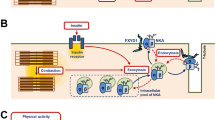Abstract
The classical role of PCr is seen as a reservoir of high-energy phosphates defending cellular ATP levels under anaerobic conditions, high rates of energy transfer or rapid fluctuations in energy requirement. Although the high concentration of PCr in glycolytic fast-twitch fibers supports the role of PCr as a buffer of ATP, the primary importance of the creatine kinase (CK) reaction may in fact be to counteract large increases in ADP, which could otherwise inhibit cellular ATPase-mediated systems. A primary role for CK in the maintenance of ADP homeostasis may explain why, in many conditions, there is an inverse relationship between PCr and muscle contractility but not between ATP and muscle contractility. The high rate of ATP hydrolysis during muscle contraction combined with restricted diffusion of ADP suggests that ADP concentration increases transiently during the contraction phase (ADP spikes) and that these are synchronized with the contraction. The presence of CK, structurally bound in close vicinity to the sites of ATP utilization, will reduce the amplitude and duration of the ADP spikes through PCr-mediated phosphotransfer. When PCr is reduced, the efficiency of CK as an ATP buffer will be reduced and the changes in ADP will become more prominent. The presence of ADP spikes is supported by the finding that other processes known to be activated by ADP (i.e. AMP deamination and glycolysis) are stimulated during exercise but not during anoxia, despite the same low global energy state. Breakdown of PCr is driven by increases in ADP above that depicted by the CK equilibrium and the current method to calculate ADPfree from the CK reaction in a contracting muscle is therefore questionable.

Similar content being viewed by others
References
Atkinson DE (1968) The energy charge of the adenylate pool as a regulatory parameter. Interaction with feedback modifiers. Biochemistry 7:4030–4034
Bessman SP, Geiger PJ (1981) Transport of energy in muscle: the phosphorylcreatine shuttle. Science 211:448–452
Chung Y, Sharman R, Carlsen R et al (1998) Metabolic fluctuation during a muscle contraction cycle. Am J Physiol 274:C846–C852
Conley KE, Blei ML, Richards TL et al (1997) Activation of glycolysis in human muscle in vivo. Am J Physiol 273:C306–C315
Dawson MJ, Gadian DG, Wilkie DR (1980) Studies of the biochemistry of contracting and relaxing muscle by the use of 31P n.m.r. in conjunction with other techniques. Philos Trans R Soc Lond B Biol Sci 289:445–455
Hancock CR, Brault JJ, Wiseman RW et al (2005a) 31P-NMR observation of free ADP during fatiguing, repetitive contractions of murine skeletal muscle lacking AK1. Am J Physiol Cell Physiol 288:C1298–C1304
Hancock CR, Janssen E, Terjung RL (2005b) Skeletal muscle contractile performance and ADP accumulation in adenylate kinase-deficient mice. Am J Physiol Cell Physiol 288:C1287–C1297
Harris RC, Edwards RH, Hultman E et al (1976) The time course of phosphorylcreatine resynthesis during recovery of the quadriceps muscle in man. Pflugers Arch 367:137–142
Hultman E, Sjöholm H, Sahlin K et al (1981) Glycolytic and oxidative energy metabolism and contraction characteristics of intact human muscle.) Human muscle fatigue: physiological mechanisms. London, Pitman Medical Ltd, 19–40
Lawson JW, Veech RL (1979) Effects of pH and free Mg2+ on the Keq of the creatine kinase reaction and other phosphate hydrolyses and phosphate transfer reactions. J Biol Chem 254:6528–6537
Lundsgaard E (1930) Untersuchungen uber Muskelkontraktionen ohne Milchsaurebildung. Biochem Z 217:162–177
McMahon S, Jenkins D (2002) Factors affecting the rate of phosphocreatine resynthesis following intense exercise. Sports Med 32:761–784
Meyer RA, Foley JM (1996) Cellular processes integrating the metabolic response to exercise. In: Rowell LB, Shepherd JT (eds) Handbook of physiology. New York, Oxford University Press, pp 841–869
Ortenblad N, Macdonald WA, Sahlin K (2009) Glycolysis in contracting rat skeletal muscle is controlled by factors related to energy state. Biochem J 420:161–168
Quistorff B, Johansen L, Sahlin K (1993) Absence of phosphocreatine resynthesis in human calf muscle during ischaemic recovery. Biochem J 291(3):681–686
Sahlin K, Palmskog G, Hultman E (1978) Adenine nucleotide and IMP contents of the quadriceps muscle in man after exercise. Pflugers Arch 374:193–198
Sahlin K, Harris RC, Hultman E (1979) Resynthesis of creatine phosphate in human muscle after exercise in relation to intramuscular pH and availability of oxygen. Scand J Clin Lab Invest 39:551–558
Sahlin K, Gorski J, Edstrom L (1990) Influence of ATP turnover and metabolite changes on IMP formation and glycolysis in rat skeletal muscle. Am J Physiol 259:C409–C412
Saks VA, Lipina NV, Smirnov VN et al (1976) Studies of energy transport in heart cells. The functional coupling between mitochondrial creatine phosphokinase and ATP ADP translocase: kinetic evidence. Arch Biochem Biophys 173:34–41
Takahashi H, Inaki M, Fujimoto K et al (1995) Control of the rate of phosphocreatine resynthesis after exercise in trained and untrained human quadriceps muscles. Eur J Appl Physiol Occup Physiol 71:396–404
Veech RL, Lawson JW, Cornell NW et al (1979) Cytosolic phosphorylation potential. J Biol Chem 254:6538–6547
Wallimann T, Wyss M, Brdiczka D et al (1992) Intracellular compartmentation, structure and function of creatine kinase isoenzymes in tissues with high and fluctuating energy demands: the ‘phosphocreatine circuit’ for cellular energy homeostasis. Biochem J 281(1):21–40
Wilkie DR, Dawson MJ, Edwards RH et al (1984) 31P NMR studies of resting muscle in normal human subjects. Adv Exp Med Biol 170:333–347
Acknowledgments
The authors’ research is supported by The Swedish Research Council Project 20654.
Author information
Authors and Affiliations
Corresponding author
Rights and permissions
About this article
Cite this article
Sahlin, K., Harris, R.C. The creatine kinase reaction: a simple reaction with functional complexity. Amino Acids 40, 1363–1367 (2011). https://doi.org/10.1007/s00726-011-0856-8
Received:
Accepted:
Published:
Issue Date:
DOI: https://doi.org/10.1007/s00726-011-0856-8




